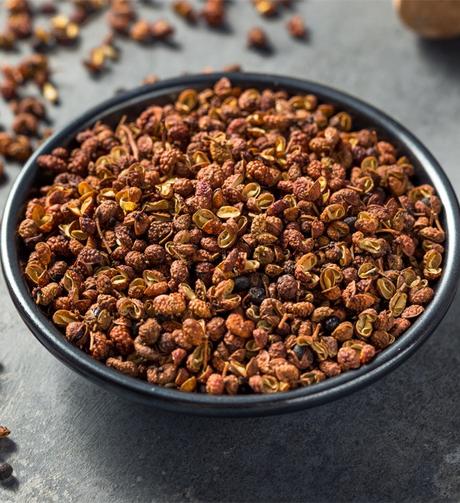
Szechuan peppercorn, also known as Sichuan peppercorn, is a mouth-numbing, fragrant spice produced from the husk of seeds of Zanthoxylum - a prickly ash scrub. It can be used both whole and grounded as both forms work excellently with other spices and herbs to enhance a recipe's flavors.
Szechuan peppercorn is one of the key ingredients in 5-spice and is commonly used in Sichuan and Chinese cuisine. It is a versatile ingredient to have on hand. But if you can't find it at your local store or supermarket, you can use these Szechuan peppercorn substitutes to give your dishes a similar spicy flavor.
1. Black Pepper
Black pepper has an earthy, hot, and peppery taste. Although it does not quite have the complexity of flavor of Szechuan peppercorn, it will add a wonderful kick of heat to any dish. Black pepper is also easier to find in any store or supermarket, which makes it an easy replacement for Szechuan peppercorn.
The pungency of black pepper works really well for flavoring veggies, soups, stir-fries, and other savory dishes. You can even use it as a garnish to spice up your dishes. However, keep in mind that black pepper does not have the fruity, citrusy flavor of Szechuan peppercorn, but you can fix that by adding a dash of lemon juice to the mix.
Use as a 1:1 substitute.
2. Grains of Paradise
Grains of Paradise, also known as alligator pepper or African pepper, are small red-brown seeds that look like peppercorns. It is a common West African spice that belongs to the ginger family. It has a citrusy, woody, spicy flavor with hints of cardamom. They're similar to Szechuan peppercorns in size, shape, and flavor, which makes them a convenient substitute.
You can use grains of paradise the same way as Szechuan peppercorns in dishes. Their warm, earthy flavor works great in a variety of dishes including salad dressings, roasted veggies, sauces, and curries. You can also combine it with other herbs like rosemary, thyme, and sage to create more complex flavors in your dish.
Substitute grains of paradise in a 2:1 ratio to Szechuan peppercorn.
3. Ground Black Pepper + Coriander Seeds
Freshly ground black pepper packs heat but also has a fruity and bright taste. But, when combined with the earthy, tart, and somewhat sweet coriander seeds, it will have a similar pine flavor with citrus notes of Szechuan peppercorn. This combination makes for a great replacement for the original ingredient in a pinch.
You can use black pepper and coriander seeds to give dishes a hint of the prized Szechuan peppercorn flavor. It will give a spicy taste to your dishes, although it will not share a likeness with Szechuan peppercorn's numbing sensation and citrusy flavor. You can remedy that by mixing in some lemon zest.
Mix ground black pepper with coriander seeds and lemon zest, then use the mix as a 1:1 substitute for Szechuan peppercorn.
4. Sansho Powder
Sansho powder is a spice made from ground berries from Japanese pepper bushes. It's a green-brown spice that has a tangy, spicy flavor and hints of citrus that will enhance your recipe's flavor. It is a key ingredient in the seven-spice mixture and lends itself beautifully to dishes that call for Szechuan peppercorn.
You can use sansho powder in a wide variety of dishes from soups and marinades to noodle dishes, sushi, and grilled meats and fish to infuse them with a lemon pepper-like flavor. However, keep in mind that sansho powder packs more heat than Szechuan peppercorn, so it may not be suitable for sensitive palates.
Use it as a 1:1 substitute for Szechuan peppercorn.
5. Sichuan Peppercorn Oil
Sichuan peppercorn oil is a neutral oil infused with the flavors of Sichuan peppers and is used to enhance any dish. Although it may be a little hard to find, it will make an incredible substitute for Szechuan peppercorn if you have it in your pantry.
You can use Sichuan peppercorn oil to replace Sichuan peppers in soups, stews, dressings, sauces, and more. It will also be a fine addition to grilled veggies, meat, and seafood. If you can't find it at your local store or supermarket, you can definitely find it Asian specialty store or just make your own using Sichuan peppercorns and peanut/canola oil.
Start with a few drops, then adjust to your desired taste.
6. Tasmanian Pepper
Tasmanian pepper, also called mountain pepper, is a spice made of little dark black berries that look like peppercorns. They have a spicy, woodsy, and floral flavor with hints of sweetness and an aroma similar to juniper and fennel. Tasmanian pepper looks very much like Szechuan peppercorn, but Tasmanian pepper has a milder flavor.
Tasmanian pepper works as a wonderful substitute for Szechuan peppercorn in a range of recipes, including stews, soups, curries, marinades, salad dressings, beef, and more. Its pungent flavor with fruity notes and the mild heat level is perfect for every palate. But, while it will enhance your dish with its flavor, Tasmanian pepper will have a slightly different taste than Szechuan peppercorn.
Start with a 1:1 substitute, then adjust to taste.
7. Tellicherry Peppercorn
Tellicherry peppercorn is a type of black peppercorn commonly grown along the Malabar coast in India. While they look similar to black peppercorns, Tellicherry peppercorns are larger as they are left on the plant for longer to mature and ripen. This process gives the peppercorn a fresh and bright citrus flavor similar to Szechuan peppercorn.
Given its complex flavor profile, you can use Tellicherry peppercorn in all kinds of dishes including soups, stews, sauces, meats, and seafood dishes. It's a versatile ingredient with a balanced flavor profile that also works well for stir-frying. Tellicherry peppercorns may be hard to come by even in specialty stores, but if you find them, they'll work amazingly as an alternative.
Use a 1:1 substitute.
